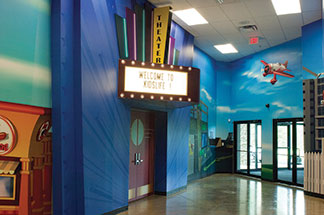
By RaeAnn Slaybaugh
Among forward-thinking church leaders, accommodating families is a top-of-mind priority. After all, meeting their unique needs fosters lifelong relationships with a church — possibly for generations to come. (And, if kids can’t wait to go to church, there’s no better endorsement for their parents!)
Yet, while it’s easy to see the appeal of kid-friendly church facilities, they’re trickier to achieve: A church must appeal to children and parents.

To strike this balance, design experts are a wealth of knowledge.
“Today’s children are the church of tomorrow!”
For Rachael Rowland, marketing director for Churches by Daniels in Broken Arrow, OK, this sentiment is the guiding force when designing spaces for children. “If a church is going to sustain itself in the future, it must invest in the kids today,” she continues. “I believe pastors realize this and have put their money where their heart is.”
Ben Beresh, director of accounts at Tulsa, OK-based Little Mountain Production, agrees. He says a revelation is happening among church leaders. “This isn’t a trend; it is a paradigm shift,” he asserts. “The church is placing more and more value on kids’ ministry in the present, to secure Kingdom growth in the future.”
Child-friendly — from the outside in
So, the case for child-friendly facilities is clear. And, according to Rowland, this mindset can be conveyed as quickly as curbside.
“One way to do this is by locating colorful play equipment where it can be easily seen,” she advises. “We worked with a church that decided to put an indoor playground located at the front of their building, surrounded by glass. When cars passed by, the kids would see it and would beg their parents to take them inside.”
Once those kids make it inside, the spaces designed to appeal to them should be age-appropriate and —most important — fun! “If the created environment is ‘cool,’ kids will place more value on it and will be excited to go back to church,” Bresher says. “Fun is the currency of children.”
As such, it’s crucial to view children’s spaces through their eyes. And what are those eyes hoping to spy? “Your [children’s spaces] should be well thought-out, color and lines, and then executed professionally,” Bresher continues. “A painter would think through his composition before ever putting a brush on the canvas. He would never just start splattering paint.”
Parent-approved design
Of course, a children’s space can’t truly be effective unless it appeals to parents, too. Personally and professionally, Rowland knows what ranks at the top of their priority list: safety and security.
“I’ve taken my kids to places because they begged me to go and because it made them so happy,” she says.
“However, I won’t even consider taking them to a place where I don’t believe they’ll be safe.”
Check-in / reception areas. From a parent’s perspective, safety and security starts at drop-off. Naturally, the first step is to make it clear where parents should go to check in their children. Translation: Attractive, visible signage.
“It’s so important to make the facility easy to navigate,” Rowland emphasizes. “If visitors can’t easily find where to take their children on their first visit, they might not want to come back.”
Once parents arrive at check-in, the setup should create excitement and anticipation in children. “This makes that first moment of separation from their parents easier,” Rowland explains.
Just as important, the check-in area should convey a sense of security to parents. According to Bresher, this means forming a “security checkpoint of sorts” so they immediately know their children can’t get out — and that adults who aren’t properly checked by security can’t get in.
![“Your [children’s spaces] should be well thought-out, color and lines, and then executed professionally,” Bresher says. “A painter would think through his composition before ever putting a brush on the canvas. He would never just start splattering paint.” (Photos courtesy of Churches by Daniels)](https://churchexecutive.b-cdn.net/wp-content/uploads/2014/10/DSC08235-1.jpg)
Shifting family dynamics necessitate a system that enables church staff to know who’s approved to pick up each child. One approach is to assign parents and guardians a unique pick-up number, a pager they can turn in upon pick-up, or a computer-generated sticker bearing the same number as the one on their child’s name tag.
“Any of these will work,” Rowland says. “But, the most important thing is that the policy be strictly implemented — whatever it is.”
Likewise, Bresher acknowledges the very complex times we live in when it comes to family. “Kids are being raised by stepparents, grandparents, older siblings — the list goes on,” he says.
For this reason, he urges churches to consider a system that guarantees, for parents, that their children: 1) will only be in the hands of qualified volunteers; 2) will never leave the designated children’s area with an undesignated individual; and 3) are always where they’re supposed to be.
Once children are checked in to the church’s care, parents want to know that strict policies and procedures are in place — particularly as children are transported from one area of the church to another.
“It’s important that no teacher is ever alone with one child,” Rowland explains. “Parents also need to be reassured that no child could stray away from the group when children are moving in a group.”
A win / win / win proposition
Though it can be a challenge to balance kid appeal with the design and security elements parents appreciate most, the effort is well worth the reward.
“Parents’ two main concerns are that the facility is safe and secure, and that their kids enjoy it,” Rowland concludes. “And, if you can get kids to love coming to your church, then you’ll get the parents to come, too.”


